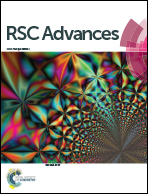Lead (Pb2+) sorptive removal using chitosan-modified biochar: batch and fixed-bed studies†
Abstract
Chitosan-Modified fast pyrolysis BioChar (CMBC) was used to remove Pb2+ from water. CMBC was made by mixing pine wood biochar with a 2% aqueous acetic acid chitosan (85% deacylated chitin) solution followed by treatment with NaOH. The characterizations of both CMBC and Non-Modified BioChar (NMBC) were done using diffuse reflectance infrared Fourier transform spectroscopy (DRIFTS), scanning electron microscopy (SEM), surface area measurements (SBET), elemental analysis, thermogravimetric analysis (TGA), differential scanning calorimetry (DSC) and ζ-potential measurements. Elemental analysis indicated that chitosan accounts for about 25% weight of the CMBC. The Langmuir maximum adsorption capacity of CMBC at pH 5 was 134 mg g−1 versus 48.2 mg g−1 for NMBC at 318 K. CMBC column adsorption studies resulted in a capacity of 5.8 mg g−1 (Pb2+ conc. 150 mg L−1; pH 5; column dia 1.0 cm; column length 20 cm; bed height 5.0 cm; flow rate 2.5 mL min−1). CMBC removed more Pb2+ than NMBC suggesting that modification with chitosan generates amine groups on the biochar surface which enhance Pb2+ adsorption. The modes of Pb2+ adsorption on CMBC were studied by comparing DRIFTS and X-ray photoelectron spectroscopy spectra before and after Pb2+ adsorption.



 Please wait while we load your content...
Please wait while we load your content...